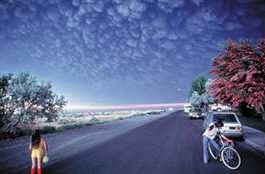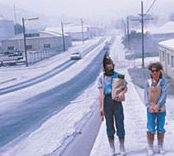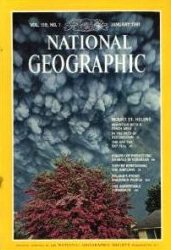

Doug Miller
Class of 1966
 “On the morning of May 18, 1980, many people in eastern Washington noticed dark, threatening
clouds approaching from the west. Most thought the clouds were part of one of the enormous
thunderstorms common in late spring. However, what they did not know was that at 8:32 a.m.
Mount St. Helens had erupted explosively, blasting an enormous column of volcanic ash and gas
more than 60,000 feet into the air.” Ephrata photographer Doug Miller was quick to get out
his camera and start recording what was to become a major event in the history of the area
and across the state. His photo received nation-wide acclaim.
“On the morning of May 18, 1980, many people in eastern Washington noticed dark, threatening
clouds approaching from the west. Most thought the clouds were part of one of the enormous
thunderstorms common in late spring. However, what they did not know was that at 8:32 a.m.
Mount St. Helens had erupted explosively, blasting an enormous column of volcanic ash and gas
more than 60,000 feet into the air.” Ephrata photographer Doug Miller was quick to get out
his camera and start recording what was to become a major event in the history of the area
and across the state. His photo received nation-wide acclaim.
 Miller took this photo of his daughters on that historic morning. The National Geographic
magazine reported regarding the photo, “This surreal-looking photo shows an enormous cloud
of volcanic ash approaching the small town of Ephrata, Washington, on the morning of May
18, 1980. The ominous cloud was from Mount St. Helens, 145 miles to the west. The volcano
had begun to erupt explosively less than three hours earlier, catching many communities
downwind unprepared for the destructive rain of gritty ash that followed.
Miller took this photo of his daughters on that historic morning. The National Geographic
magazine reported regarding the photo, “This surreal-looking photo shows an enormous cloud
of volcanic ash approaching the small town of Ephrata, Washington, on the morning of May
18, 1980. The ominous cloud was from Mount St. Helens, 145 miles to the west. The volcano
had begun to erupt explosively less than three hours earlier, catching many communities
downwind unprepared for the destructive rain of gritty ash that followed.
“As the clouds drifted overhead, a rain of ash began to fall, plunging much of the region into darkness that lasted all day. Homes, farms, and roads were quickly covered by as much as 4 inches of gritty ash. The smallest ash particles penetrated machinery and all but the most tightly sealed structures. By the end of the day, more than 500 million tons of ash had fallen onto parts of Washington, Idaho, and Montana. The ash prevented travel throughout much of eastern Washington because of poor visibility, slippery roads, and ash-damaged vehicles, stranding more than 10,000 people and isolating many small communities.
 “More than $1 billion in property and economic losses was caused by Mount St. Helens' 1980
eruption—much of it by ash. Future large explosive eruptions in the United States are
certain to produce widespread ash falls and are likely to cause even greater losses. Since
1980, rapid population and economic growth in the Western United States, widespread use of
computers and electronics, and the dramatic increase in jet-airline traffic, especially
over the North Pacific, have made more people and property in the Nation vulnerable to the
effects of volcanic ash. Knowing the characteristics of volcanic ash and being prepared when
a volcano shows signs of restlessness can significantly reduce the potential economic and
health impacts of airborne and falling ash.”
“More than $1 billion in property and economic losses was caused by Mount St. Helens' 1980
eruption—much of it by ash. Future large explosive eruptions in the United States are
certain to produce widespread ash falls and are likely to cause even greater losses. Since
1980, rapid population and economic growth in the Western United States, widespread use of
computers and electronics, and the dramatic increase in jet-airline traffic, especially
over the North Pacific, have made more people and property in the Nation vulnerable to the
effects of volcanic ash. Knowing the characteristics of volcanic ash and being prepared when
a volcano shows signs of restlessness can significantly reduce the potential economic and
health impacts of airborne and falling ash.”
Cover Photo by Douglas Miller

 The city of Ephrata was rightfully proud to have a photo taken by Doug Miller, Ephrata High
School 1966 graduate, appear on the cover of the National Geographic. Doug and his wife,
Madalyn Waltho Miller, EHS ’68, for years served the community of Ephrata through their
Miller’s Photography business. The main purpose of their business was to record the special
family happenings of births, baptisms, graduations and weddings. They also served their
alma mater; photographing class pictures, senior pictures, school dances, activities and
sporting events along with many class reunion gatherings.
The city of Ephrata was rightfully proud to have a photo taken by Doug Miller, Ephrata High
School 1966 graduate, appear on the cover of the National Geographic. Doug and his wife,
Madalyn Waltho Miller, EHS ’68, for years served the community of Ephrata through their
Miller’s Photography business. The main purpose of their business was to record the special
family happenings of births, baptisms, graduations and weddings. They also served their
alma mater; photographing class pictures, senior pictures, school dances, activities and
sporting events along with many class reunion gatherings.
Miller’s Photography was more than just a business on a side-street of Ephrata. Doug and Madalyn were friendly and gave generously of their time as they went about their business of recording “The Story of Ephrata’s People.”
For more information about Mount St. Helens, click here:
© 2014 - Ephrata Alumni Association
Ephrata High School, 333 4th Avenue NW, Ephrata, Washington 98823